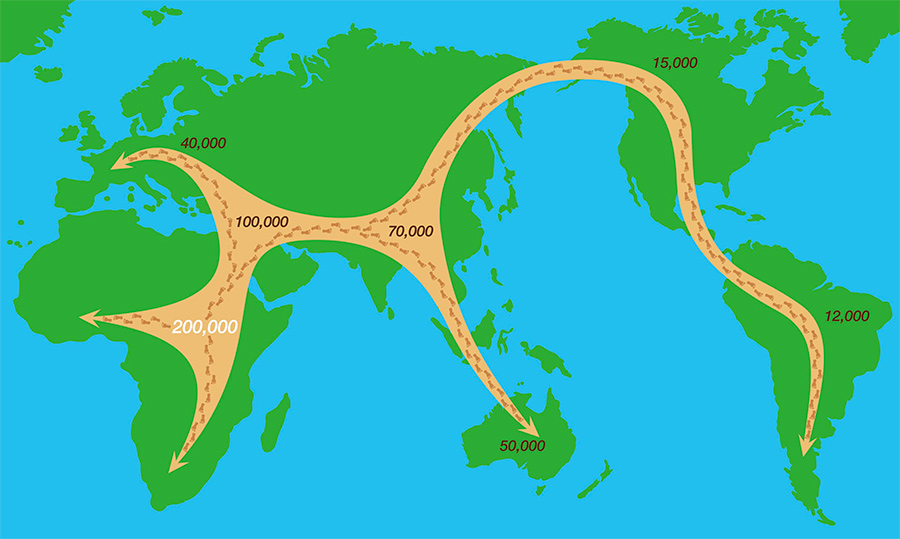- By 70,000 years ago, fully modern humans have evolved, because hominins leave Africa at that time and that founder population must have been a modern human.
- As they dispersed, they encountered other human species, such as Neandertals in the west and Denisovans in the east, and interbred with them.
Highlights
The Origins of Modern Humans
Modern humans are a species where culture is our primary form of adaptation. Among all hunter-gatherers, that culture has rich traditions, complex rules and norms, complicated ways to organize kinship, institutions to regulate behavior, and highly effective technology. The capacity for that culture rests in a highly evolved cognition, some very special forms of social learning, and a proclivity to cooperate even with unrelated individuals. The culture of modern humans probably is not possible without these three features, and they are evolved into an interconnected system of cognition and psychology and emotion and physiology.
Species moving out of Africa
By the time of Homo heidelbergensis, its brain size was already very large, yet the archaeological record does not show the kind of cultural adaptation we expect of a modern human. This tells us that brain size alone is insufficient to make a highly cultural species like modern humans, so other things have happened beyond brain size. There is evolution within the mind and psychology and emotions that goes on to produce a modern human. The anatomical record alone is unlikely to illuminate these final changes that result in modern humans.

Homo heidelbergensis skull.
Image credit Heidelberensis image archaeology.com. Courtesy Javier Trueba, Madrid Scientific Films) https://www.archaeology.org/issues/125-1403/trenches/1806-human-dna-homo-heidelbergensis-denisovan-lineage
The anatomical record identifies Homo sapiens at around 300,000 million years ago. This is a recognition that a species of hominin is present that, at least in anatomy, falls within the range of variation of modern humans. However, it is important to recognize that this hominin is not necessarily a modern human with all the cognitive and psychological and emotional machinery that we have. One thing we know is that by 70,000 years ago, fully modern humans have evolved, because hominins leave Africa at that time and that founder population must have been a modern human.
Where, when, and why?
That identifies a key research question—when between 300,000 and 70,000 years ago did that modern human lineage evolve, and where in Africa, and of course all the “whys” that go along with that. The archaeological record provides a source for probing when these key features of modern humans evolved, and perhaps where and why.
This leads us to some interesting research questions. When did these three (highly evolved cognition, some very special forms of social learning, and a proclivity to cooperate even with unrelated individuals) distinctly modern human qualities evolve? Did they evolve in one location in Africa and spread out, or did they evolve synchronously across Africa? Did they evolve all at the same time, or were they staggered in their evolution? What was the context for their evolution, and were there some primary drivers? For example, paleoanthropologists have a long tradition of examining the relation between climate change, environmental change, and human evolution. Was climate and environmental change a primary driver in later hominin evolution?
All of these questions remain unanswered, but vigorous research has resulted in some spectacular discoveries and advances that have revolutionized our understanding of the record for the evolution of modern humans.

Migration out of Africa was not just once or only one way.
Image credit Shutterstock
Founder population
Around 70,000 years ago, a founder population of this modern human species left Africa and spread across Eurasia. As it dispersed it encountered other human species, such as Neandertals in the west and Denisovans in the east, and interbred with them. Interbreeding between closely related contiguous species is common in nature, and normally the hybrids do not survive at high rates, but some do. This was clearly the case here because all Eurasians have some Neandertal DNA while some southeast Asian peoples have some Denisovan DNA. We expect that these genes that “introgressed” and persisted in modern humans had positive effects and studies are starting to reveal these features.
How far were they going?
What was the pace and character of the Great Modern Human Diaspora? This is a quickly changing field of study and many things said today are out of date tomorrow. One vexing challenge is that one of our best dating tools, C14 dating, provides increasingly unreliable dates stating around 38,000 years ago and begins to end in efficacy at about 45,000 years ago. Most sites in the past were dated with C14, and perhaps it is not surprising that in many regions of the world the entry of technologies thought to belong to modern humans is dated to 45,000 years ago. This is likely a methodological artifact, and recent studies using other dating techniques are pushing this date back.
For example, the entry of modern humans into Australia is now pushed back to 65,000 to 60,000 years ago using optically stimulated luminescence dating. Modern humans seem to have spread across the Old World very quickly, even penetrating into circumpolar environments before 45,000 years ago. The harsh Arctic seas and ice sheets seem to have held them back from entering the New World for thousands of years. Most scientists have thought that modern humans entered North America between 15,000 to 13,000 years ago, but that date is now challenged by new evidence, and there is increasing, but controversial evidence, that human entered North America by 23,000 years ago.

Image credit Erich Fisher
Modern humans are the most invasive species (an article in Scientific American talks more about this idea— https://www.scientificamerican.com/article/how-homo-sapiens-became-the-ultimate-invasive-species/ —you may need a subscription to read the entire article), penetrating every environment on the planet and shaping it in profound ways, both intentional and unintentional. Invasive species in general can have catastrophic impacts on the environments they penetrate and that was the case with modern humans. Shortly after modern humans enter western Eurasia, Neandertals go extinct. Similarly, in eastern Eurasia, Denisovans go extinct, though we don’t have a date on this yet. In many regions, massive numbers of mammals go extinct, and many scientists think that overhunting by modern humans caused these extinctions. Exactly if and how modern humans were related to these extinctions remains a hotly debated topic.
Written by Curtis Marean PhD